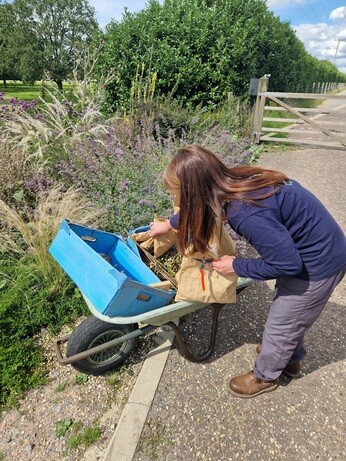Find out what the garden and propagation teams have been up to this week.

Seed collecting with propagation expert Emily

‘Hundreds of bags and boxes of seed, collected from the garden during the summer and autumn, need to be sorted and sieved and then put into envelopes saved from the post, ready for sowing next month. It is a job I enjoy; delving into the piled-up cardboard boxes, tipping out large and small paper bags stuffed full of seed heads, wondering at the diversity of design in seed-cases, everyone different.’
-Beth Chatto
Seed collecting and storage
Seed collecting is an essential task that keeps propagation expert Emily busy at this time of year. A large amount of our own-grown plants are raised from seed collected from parent plants growing in Beth’s garden. Many of these plants would have started life as seedlings propagated by Beth herself and nurtured over many years. Emily spent many years working alongside Beth, learning her techniques. Seed collecting starts as early as April with Anemone pavonina, and carries on throughout the growing season until late autumn.



With the constantly changing weather conditions, it’s important that Emily and the team keep a close eye on developing seed heads to ensure they collect the ripening seed before it falls. Our recent damp weather has made it difficult to collect seed, as ideally, they would be gathered and stored when dry to ensure they don’t rot in storage. If the weather is too hot and dry, it encourages the seed to ripen quickly and disperse before the team has had chance to collect them.


How to collect seed
The method of collecting seed is a simple one involving basic equipment including paper bags, snips and buckets. The tricky part is knowing when is the right stage to collect. Emily and the team will keep a close eye on seed heads as they continue to develop, trying to catch them as they ripen.
When the time is right, seed heads are cut from the plant and placed in either labelled paper bags or buckets, depending on the size and quantity. The bags are placed in boxes and kept in the propagation tunnel to continue the drying out process. The larger quantities of seed heads collected in buckets, are tipped into boxes lined and covered with newspaper.

Seed cleaning and storing
Finally, when the seed has collected in the bottom of the bag or box, it is then sieved to remove any unwanted material and stored in labelled and dated paper envelopes. These envelopes are then kept in plastic storage boxes in a dark, cool place until they are ready to sow. Some seed is best when sown fresh so won’t be stored but sown straight away. Some plants also don’t like to be transplanted so are best sown directly where are to be grown. We sell the seeds of these plants in our shop so our customers can get better results by sowing directly themselves.
Watch our short videos with Emily here:

Read on: A Guide to Seed Sowing
![]()

COMMENTS